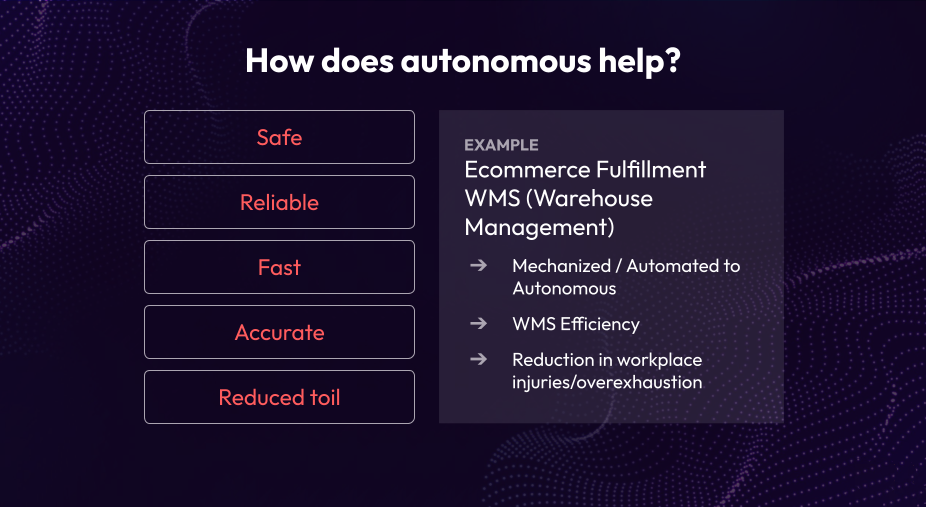Attend a Live Product Tour to see Sedai in action.
Register now

March 28, 2024
April 9, 2024
.png)
This article, based on the kickoff session from the autocon/22 conference, sets the stage for the event by outlining the significance of autonomous systems in cloud management. It explores how autonomous systems have revolutionized various industries and highlights their transformative potential. The conference, autocon22, showcased the latest advancements and real-world implementations of autonomous cloud management, making it a groundbreaking event for experts and innovators in this rapidly evolving field or autonomous cloud management. Watch the original video here for more insights.
The impact of autonomous systems extends far and wide, permeating diverse sectors such as transportation, warehousing, and aviation. From self-driving cars gracefully navigating our roads to autonomous warehouses streamlining complex logistics, these systems have revolutionized operational efficiency and productivity. Even within the comforts of our homes, we now benefit from autonomous tools that simplify our daily routines.
Cloud management, in particular, has experienced a significant transformation due to the rise of autonomous systems. As cloud technologies continue to evolve at a rapid pace, the need for intelligent, self-managing systems becomes increasingly critical. autocon22 delved into the forefront of autonomous cloud management by exploring the latest advancements, sharing best practices, and showcasing real-world implementations.
Throughout history, we have witnessed the remarkable evolution of systems. What began as mechanized processes supported by human effort has evolved into the advent of automatic systems, streamlining tasks and paving the way for increased efficiency. However, a new wave has emerged, ushering in the era of autonomous systems that have the ability to seamlessly handle mundane and repetitive tasks with minimal human intervention. These autonomous systems have permeated our lives, revolutionizing various industries, from the widespread use of self-driving cars and the optimization of smart warehouses to the implementation of copilot systems that support and enhance the skills of pilots.
The journey from manual labor to automation has been awe-inspiring, but the recent advancements in autonomy have taken us to new heights. Multiple levels of autonomous systems have emerged, each exhibiting varying degrees of independence and intelligence. These systems have the capacity to execute tasks efficiently, allowing human intervention only when necessary. By delegating repetitive and mundane tasks to autonomous systems, we free up valuable human resources to focus on more complex and creative endeavors.

Autonomous systems operate along a spectrum of autonomy, ranging from level one to level five. The majority of systems currently fall within levels two to four, exhibiting a remarkable ability to handle substantial workloads while necessitating human intervention only in critical scenarios. This paradigm shift brings forth tremendous advantages and opens up new possibilities across various industries.
One area where the impact of autonomous systems is particularly notable is e-commerce. Warehouse management systems have embraced autonomy, ushering in a wave of innovation that enables retailers to provide swift delivery services. Thanks to autonomous systems, retailers can fulfill orders within a day, and in some cases, even within a matter of hours. This transformative shift in the e-commerce landscape has revolutionized customer expectations and created unparalleled convenience.

Embracing autonomous systems brings forth increased efficiency in various domains. They empower us to accomplish tasks faster and safer, while also alleviating exhaustion and reducing toil for operators. For instance, imagine the time and effort saved when autonomous systems are deployed to manage production clouds, allowing engineers and Site Reliability Engineers (SREs) to focus on higher-value activities. A recent survey conducted by Google revealed that SREs spend a significant portion of their time, approximately 70%, on mundane tasks. Implementing autonomous systems can revolutionize their daily workflows and drive substantial improvements. Please check this article for your reference.
AutoCon22 served as a platform to explore the forefront of autonomous cloud management. The conference featured a remarkable lineup of speakers from leading companies who are driving exciting innovations in this domain. One of the key challenges discussed was observability and the selection of relevant metrics from the vast array available. Tsahi Peleg from Palo Alto Networks and Nikhil Gopinath from Sedai shared valuable insights on tackling this challenge.

There is a wide range of applications for autonomous systems from AI-powered copilots to highly efficient warehouse management systems. Autonomous cloud management represents a new frontier that can unlock unprecedented levels of efficiency, productivity, and innovation in cloud management.